Photographs in the novel Extremely Loud and Incredibly Close
Final draft (pre-editing) of a chapter published in:
Picturing The Language of Images, Cambridge Scholars Publishing, 2013.
Jonathan Safran Foer’s novel Extremely Loud and Incredibly Close won the Book Illustration Award and was named Overall Winner at the Victoria and Albert Illustration Awards in 2005. This was an unusual win on two counts. First the “illustrations” are mostly found photographs, rather than original images created by the author. Although Foer took some photographs himself most were sourced from stock libraries, web sites and The New York Times. Second it is unusual for a novel to contain photographic illustrations at all. Novels are conventionally a purely written literary form; images are drawn in the mind of the reader, and not on the page of the book. In addition to the photographs scattered amongst the written text, are a range of other graphic images: diagrams, handwritten text, and unconventional typesetting. Director Mark Jones calls the work a “rare and impressive example of a text with fully integrated visual elements, in which you encounter things you don’t expect” (Khan n.p.).
Jones accentuates that the photographs and other images are “rare and impressive” because they are “fully integrated” in the novel. Early novels often had illustrated plates scattered through the text or photographic frontispieces, and there is a long tradition of publishing special illustrated editions of classic or best-selling novels. However, these kinds of images have traditionally been included as decorative elements in novels—ornate title pages or illustrated plates could be added or subtracted in different editions without significantly affecting the comprehension of the writing. Foer’s novel differs from illustrated literature of the past because the images are included as literary devices. They do not merely reflect or illustrate the writing; they are part of the writing.
Foer is not the only novelist pushing the limits of the genre by using images as literary devices. “Hybrid novels”—novels with graphic elements such as such as photographs, drawings and diagrams integrated into the written text—are increasingly common. Other examples of hybrid novels include Umberto Eco’s The Mysterious Flame of Queen Loana, Dave Eggers’ You Shall Know Our Velocity, W.G. Sebald’s Vertigo and The Rings of Saturn, Douglas Coupland’s JPod, Mark Hammond’s The Curious Incident of the Dog in the Night-time, Marisha Pessl’s Special Topics in Calamity Physics, and Salvador Plascencia’s People of Paper. In an interview on BBC Radio4’s Open Book program, design critic Rick Poynor points to these books as a phenomenon to watch out for:
There’s going to be a lot more of this—it makes sense. We are constantly told that ours is now a culture of the image, we are told that people have achieved a higher level of visual literacy, we know that the book is supposedly struggling to find readers … but if you want to attract younger readers, if you want to attract the generation that really is addicted to its gadgets, then it makes sense to produce a literature that has an added visual dimension. (Frostrup n.p.)
Hybrid novels present a reading experience that demands visual as well as verbal literacy. For readers and critics accustomed to conventional, purely verbal novels, “reading” images as part of a text can be challenging. Margo Hammond, book editor of the St Petersburg Times, discusses the issue of critics with a primarily linguistic background critiquing hybrid works, and suggests that those literate in both verbal and visual communication should offer analysis of hybrid texts:
[I]t is the text that is usually examined most closely, with commentary on the artwork brought in as an afterthought. What should be considered, it seems to me, is the interplay between the two art forms, which lies at the heart of why these works differ from any other. […] As our society gets more and more visually sophisticated, we need to seek out those who can understand, analyze, and translate for us that interplay. (Hammond & Heltzel n.p.)
Understanding the interplay between words and images is fundamental to design practice since designers communicate ideas through typography and images. Wendie Wulff claims that this bilingual knowledge of word and image puts designers in a unique position to analyse and explain hybrid texts:
It is possible that […] designers have an advantage in these situations. Everybody learns to communicate with words, both orally and in writing, while most people—unless they study design or art—are not able to communicate effectively with visual representations. (9)
This article demonstrates how a designer’s analysis can shed light on the way in which images function as literary devices in hybrid novels. This analysis is offered as a counterpoint to, rather than replacement of, traditional literary criticism. It focuses on one type of image—photographs—in Safran Foer’s novel Extremely Loud and Incredible Close.
Extremely Loud is narrated by Oskar Schell, who is 9-years-old when his father Thomas dies in the September 11 attack on New York City. Trapped in the second tower of the World Trade Center, Thomas leaves five messages on the family answering machine that Oskar returns home to hear. The last message is left moments before the tower falls, while Oskar is at home, but too frightened to pick up the phone. Filled with shame, Oskar buys a new answering machine to hide the messages from his mother. Oskar is devastated by his father’s death, and wracked with guilt about replacing the answering machine: “That secret was a hole in the middle of me that every happy thing fell into” (71).
Oskar describes his grief as “wearing heavy boots”, answers “I’m okay” when his name is called, dresses exclusively in white, and claims to competently play Flight of the Bumblebee on the tambourine. One reviewer describes him as “the kind of child that adults adore and kids love to pick on” (Jain n.p.).
To Oskar’s despair, a year after the tragedy his mother develops a friendship with Ron, a man from her trauma support group. Sulking in his father’s closet while his mother and Ron play Scrabble, Oskar accidentally breaks an unfamiliar blue vase. Inside, is a small envelop with the word “Black” written in red pen, in Thomas’ handwriting. Inside the envelope is a key. Oskar imagines this key is a mystery he must solve, and speculates that ‘Black’ is a name belonging to someone who knew his father: “I decided I would meet every person in New York with the last name Black. Even if it was relatively insignificant, it was something, and I needed to do something, like sharks, who die if they don’t swim, which I know about” (87).
For most of the novel, Oskar tramps across New York city, knocking on the doors of various eccentric people whose surname is Black, hoping to find the lock to match this mysterious key, but mostly trying to keep his father present in his daily life.
Oskar’s grandparents—Grandma and Thomas Senior[1]—narrate two letters, which run parallel to Oskar’s narrative. Across these letters, Foer presents two adult perspectives of grief alongside Oskar’s. His grandparents met in Germany during the Second World War, but were not lovers; an adolescent Grandma used to spy on Thomas Senior kissing her older sister, Anna. After Anna dies, pregnant with his child, in the firebombing of Dresden, Thomas Senior falls permanently mute from grief. Years later, he unexpectedly meets Grandma in a New York city bakery; they marry out of mutual bereavement for Anna and create a stifling silent life together. When Grandma falls pregnant, Thomas Senior feels she has betrayed the rules of their union and deserts her, fleeing back to Dresden. He returns to New York only after forty years, too late to meet his son. Grandma allows him to move into the spare room in their apartment, but refuses to let him meet Oskar. Slowly, he does befriend his grandson, but is known to Oskar only as Grandma’s “renter”.
In addition to these three narrative strands – Oskar’s, Grandma’s and Thomas Seniors’ – a collection of photographs are presented as a fourth, visual narrative. Two types of photographs appear in the novel—images sourced from the Internet and newspapers by Oskar, and original photographs taken by Oskar and Thomas Senior. Thomas Senior has a camera, which he uses to document his apartment for insurance purposes. He leaves it, and everything else, behind when he flees. Grandma gives the camera to Oskar, who uses it to document the people and events he encounters on his travels. These photographs are presented as belonging to Oskar and Thomas Senior, and not to the author. Thomas Senior and Oskar both photograph banal, everyday things. Both characters are troubled by the loss of a loved one, and feel out of place in the world. Hiding behind the lens of a camera allows them to document their lives, and to reflect on the everyday from behind the safety of a lens. The (same) camera is a screen between these characters and the worlds they are both estranged from – Oscar is estranged from his life in New York City post-911, especially with the loss of his beloved father; Thomas Senior is estranged from his life post-WW2, especially with the loss of his love Anna and their unborn child. Both characters keep the photographs they capture in private diaries, as a way to reflect upon their worlds.
The photographs are integrated into the novel in three ways: 1) a six-page photographic frontispiece, 2) as pages from Thomas Senior’s “day books”, 3) and as pages from Oskar’s “Stuff That Happens to Me” book.
1. Photographic frontispiece
Between the cover and the preliminary pages lie three full-page photographs.

The frontispiece of a novel is a framing device that visually introduces important themes and symbols. Similar to title sequences in film and television, frontispieces are evocative rather than descriptive. Below, each frontispiece photograph is described in relation to a key theme or idea in the novel.
Frontispiece Photograph One: Keyholes and Doorknobs
The first frontispiece photograph is an extreme close-up on the keyhole of a door. Due to its ambiguity, readers are forced to ask: Are we peering through the hole or noticing the missing key? Keyholes are associated with mystery—the unknown behind a locked door, and also voyeurism—hidden observers, peeping into a private space. Read literally, this image represents Oskar’s quest to find the lock that fits his mysterious key. More metaphorically, the locked door represents the characters’ inability to communicate their grief to each other.
In addition to this frontispiece image, five photographs of doorknobs appear within the novel, on pages 29, 115, 134, 212 and 265. These photographs are reproduced only in the chapters narrated through Thomas Senior’s letters. Thomas Senior manically photographs the apartment he and Grandma share in New York when they are first married, documenting literally every angle and object within, and pastes these photographs into his “daybooks”—the notebooks he carries with him to write down what he can’t say. Thomas Senior rips pages from his daybooks to write letters, some of these pages contain doorknob photographs. These abstractly relate to written descriptions of keyholes and doorknobs that appear throughout. Grandma describes Thomas Senior peeking through a keyhole to see Oskar: although she allows Thomas Senior to stay in the spare bedroom when he returns, she punishes him by refusing to introduce him to Oskar. Desperate, he suggests: “I’ll hide in the coat closet and look through the keyhole.” (276) His first view of Oskar is through that keyhole, and he later states, “I wanted to carry the closet door with me so I could always look at him through the keyhole” (278).
Both verbal and photographic descriptions of doorknobs and keyholes appear in different contexts, and in different ways throughout the novel. These descriptions are neither immediately obvious nor perfectly clear upon reflection. The question ‘what does the door mean in the novel?’ has no single answer, nor does the question ‘what does the photograph of the door mean?’. The doorknob / keyhole device is a recurring theme, both linguistic and graphic, that is allowed to float polysemically. Whereas Oskar literally has a key and is searching for a lock, Thomas Senior is metaphorically locked, and in search of a key to open himself up.[2]
Frontispiece Device Two: Birds in Flight
We infer Oskar has snapped this second frontispiece photograph because a cropped version appears within one of his chapters, blown-up into a double page spread. Early in his quest, Oskar befriends a reclusive, elderly Mr Black who lives upstairs in his building. This Mr Black accompanies Oskar on his quest to find other Blacks. Mr Black has not left his apartment for twenty-four years and turned his hearing aids off to save the batteries. Oskar convinces him to turn them back on, describing what happens in a combination of words, interrupted by a large image:
Then, out of nowhere, a flock of birds flew by the window, extremely fast and incredibly close. Maybe twenty of them. Maybe more. But they also seemed like just one bird, because somehow they all knew…
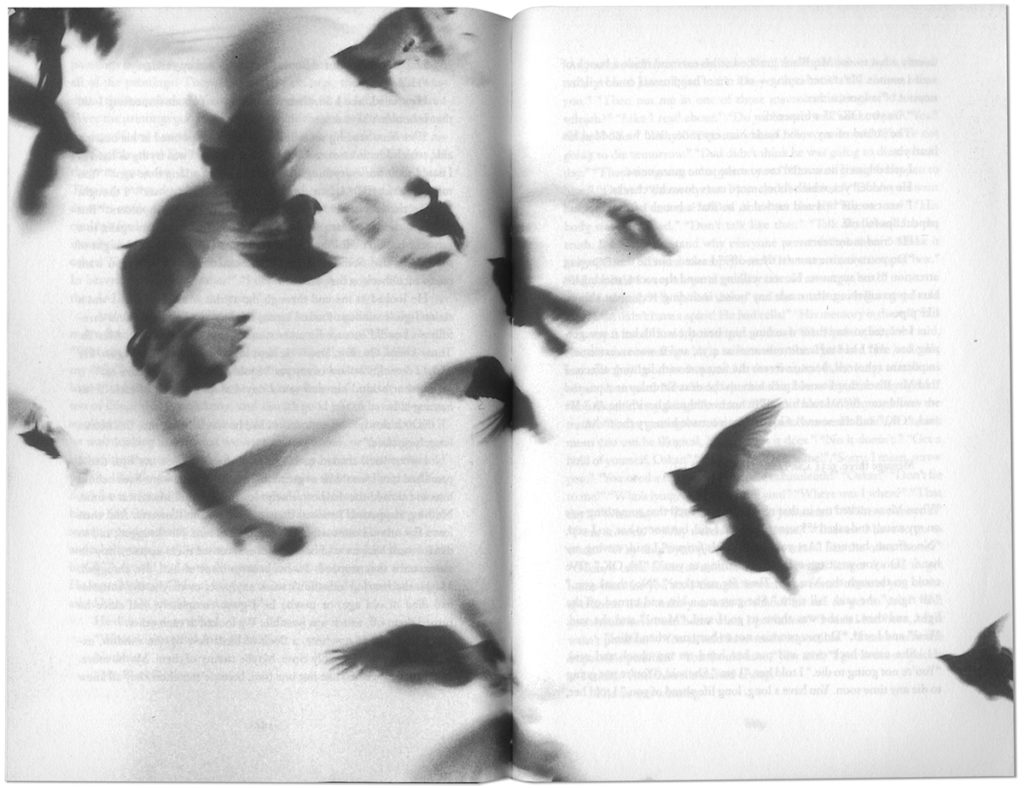
exactly what to do. Mr Black grabbed his ears and made a bunch of weird sounds. He started crying—not out of happiness, I could tell, but not out of sadness, either. (168)
The image bleeds off the spread, as though the birds are too loud and fast to be contained within the grid. Turning the page, mid-sentence, this oversize image is unexpected and amplifies the moment for us, reflecting the experience of the characters. The moment Mr Black’s hearing aids are turned on again, the world comes rushing in at him, described verbally and visually through the metaphor of a flock of birds appearing from nowhere, ‘extremely loud and incredibly close’. The title of the book appears within the text for the first time at a moment that is bewildering – Oskar recognises that it is neither happiness nor sadness, but an emotion so strong that it caused a grown man to weep. Mr Black’s reluctance to leave his apartment or turn on his hearing aids represents a fear of the outside world that mirrors Oskar and Thomas Senior’s post-traumatic anxiety.
Flight, in the human sense of fleeing from grief and responsibility, is a recurring theme in the novel. Through his quest for the lock, Oskar flees from the reality of his father’s death. Thomas Senior deserts his pregnant wife, fleeing the responsibility of fatherhood.
In a more literal sense, flight also recurs in Oskar’s obsession with a photograph he finds on the Internet. This blurry photograph could almost be a blown-up image of a bird. But, it is not. Oskar found the now well-known pictures of people jumping from the second tower on September 11 to avoid burning to death.[3] He wonders whether this “falling man” is his father. Throughout the novel, Oskar imagines many safety inventions, one of which is a birdseed shirt: “there are so many times when you need to make a quick escape, but humans don’t have their own wings, nor not yet, anyway, so what about a birdseed shirt?” (2)
This birdseed shirt is referenced several other times—always in moments when Oskar is thinking about his father’s death. In one passage, when Grandma mentions the birdseed shirt as a joke, Oskar becomes upset; when she asks what’s wrong, he tells her he misses his father (71). In another passage, Ruth Black, who guides tours around the Empire State Building, explains to Oskar that during the spring and autumn bird-migration, the lights on the building are turned off on foggy nights to prevent confused birds flying into the building. Oskar says to Ruth:
‘Ten thousand birds die every year from smashing into windows,’ because I’d accidentally found that fact when I was doing some research about the windows in the Twin Towers. … ‘so I invented a device that would detect when a bird is incredibly close to a building, and that would trigger an extremely loud birdcall from another skyscraper, and they’d be drawn to that. They’d bounce from one to another.’ … ‘But the birds would never leave Manhattan,’ Ruth said. ‘Which would be great,’ I told her, ‘because then your birdseed shirt would be reliable.’ (250)
The falling man image is discussed in more detail shortly, but here, a connection is clearly made between this falling body (possibly Thomas?) and the birds. The photograph of birds in flight, like the doorknobs, can be read in multiple ways, and related to different aspects of the novel.
Frontispiece Photograph Three: Apartment Building
The third frontispiece photograph is a blurry shot of an apartment building presumably taken by Oskar from his apartment, which directly faces Grandma’s apartment. The same photograph appears again when Oskar describes setting up two-way radios between their facing buildings, so they can speak first thing in the morning and last thing at night. Within the chapter, this photograph is tightly cropped; it is an extreme close up of just one window. Isolated, this window begs for closer inspection:
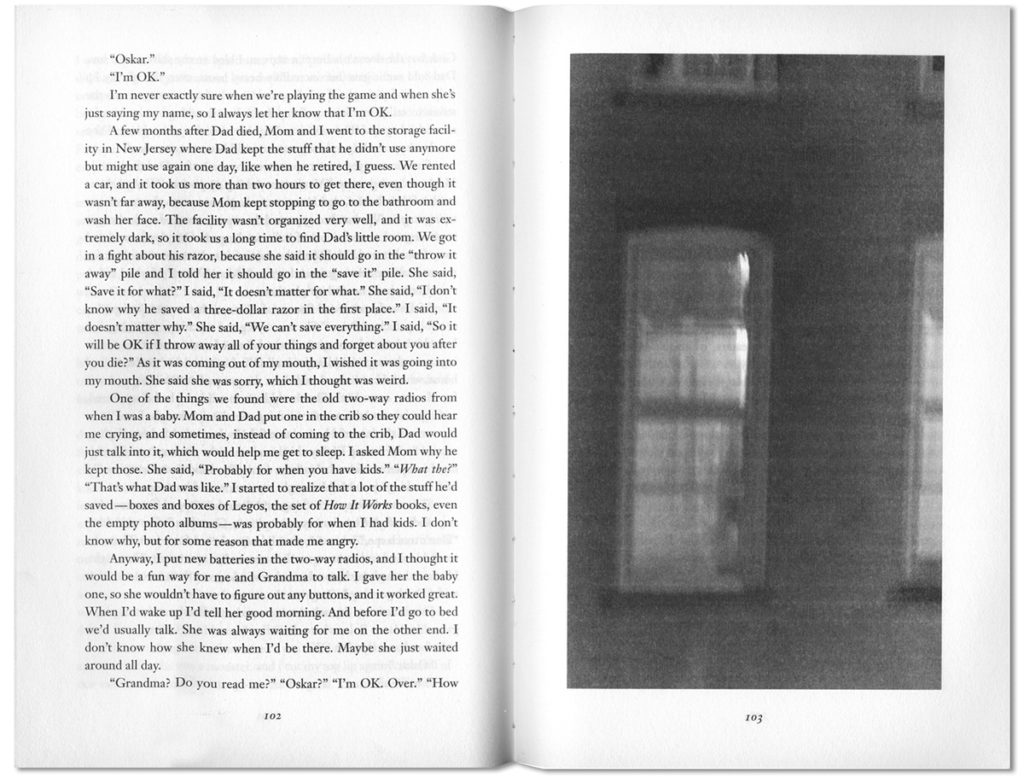
Upon careful consideration, readers ponder as to whether the dark smudge on the right is a person peeking through the curtains at us, perhaps Grandma. The photograph is poorly focused, and the reproduction blurry. This blurriness may visually reiterate the idea that Oskar, a child and amateur photographer, took the photograph – a more artistically resolved image would be inauthentic, as discussed further below. The blurriness also reflects a mundane kind of voyeurism, reflected in the narrative surrounding it:
‘I asked how did you sleep. Over.’ ‘Fine,’ I’ll say, looking at her across the street, my chin in my palm, ‘no bad dreams. Over.’ ‘One hundred dollars. Over.’ We never have all that much to say to each other. (104)
Thomas Senior watches Oskar through a cupboard door, Grandma through a window. Both are watching, incredibly close.
In addition to introducing central themes, by introducing unexpected photographs in the frontispiece, Foer prepares readers for the presence of photographic devices, before we slip into the world of the novel.
2. Scattered Photographs
While visiting the various Blacks, Oscar documents his journey with his camera (formally Thomas Senior’s camera). Retelling some stories, Oskar mentions taking photographs that are not included within the narrative. For example, none appear in the account of visiting a wealthy woman’s uptown apartment where he inadvertently offends the African-American maid by being overly complimentary. Oskar seems to omit pictures of experiences that were very uncomfortable, perhaps too self-conscious to pull out his camera, or not wanting to remember them in detail.
The description of meeting Abby Black, the second name in the phonebook, contains three photographs.
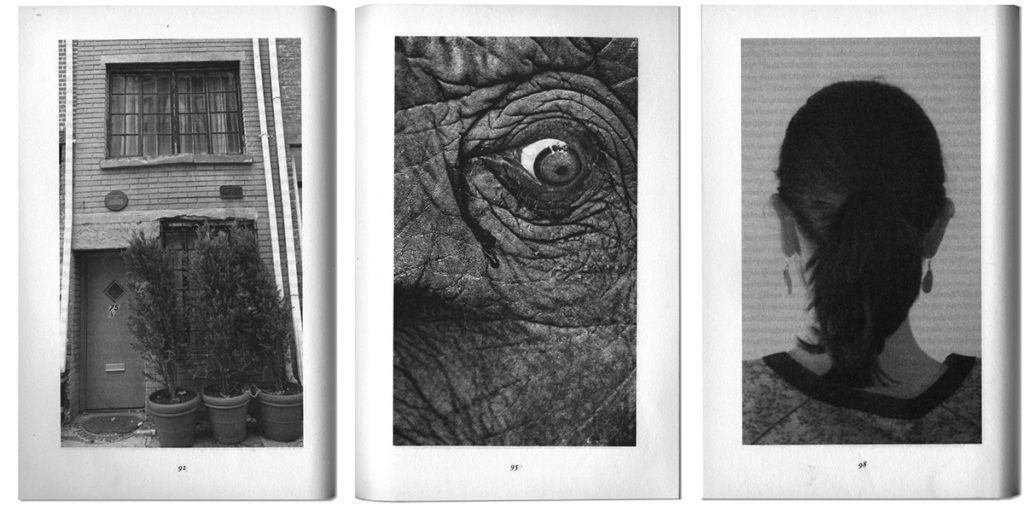
It is an awkward meeting: Oskar has walked into a domestic argument (obvious to us but not him, the scene is heavy with dramatic irony). While he speaks to Abby, her husband lurks in the background; Oskar describes him as a “desperate person” in the other room. When Oskar informs Abby that humans are the only animals who cry, she replies that the elephant on her wall appears to be crying. Oskar photographs this photograph, to reflect on later. The image is strange and haunting, its eye rolling to the side as if in terror or pain. At one point, Abby bursts into tears and Oskar thinks: “I’m the one who’s supposed to be crying” (96). A moment later, he asks: “Could we kiss for a little bit?” She politely refuses, explaining she is forty-eight and married, and he is a child. The elephant photograph adds to the strangeness and discomfort of the scene. In lieu of a kiss, Oskar asks to take Abby’s photograph, but explains: “When I started focusing Grandpa’s camera, she put her hand in front of her face for some reason. I didn’t want to force her to explain herself, so I thought of a different picture I could take, which would be more truthful, anyway” (99).
The photograph of the back of a woman’s head appears nearby. Why does Oskar suggest this image is more truthful? Oskar’s statement (quoted above) provides an in-text caption to the image, telling us he took a picture implies that this is the photograph he took, but this “caption” does not pin a meaning to the image.
Almost two hundred pages and a lot of door-knocking later, it turns out Abby’s “desperate” husband was the owner of the lock that fits Oskar’s key all along. Immediately after Oskar leaves her house, Abby leaves him a phone message saying she was not completely honest and may be able to help him, but—for obvious reasons—Oskar is hesitant to listen to answering machine messages. He does not receive Abby’s message for eight months. However, upon hearing the message, he rushes straight over to Abby’s house. The photograph of her house is once again introduced. Abby explains that her husband, William, may own the lock the fits his key, and Oskar arrives at William’s office to discover William has been searching for the key for two years. After selling his own deceased father’s possessions, William discovered a letter informing him of a safety deposit box key hidden in a blue vase, the blue vase Oskar’s father bought, and Oskar accidentally broke. Oskar does not mention photographing William, the Black he has spent so long hunting, but includes a photograph of the back of a man’s head, similar to Abby’s portrait.
The phrase “we were incredibly close” is repeated several times in the passages describing Oskar’s encounters with Abby and William Black, yet Oskar photographs the back of their heads. These are the only photographs of “real people” (characters) that appear in the book. By drawing attention to these characters with the photographs, the reader is invited to spend more time with them, to consider why they have been depicted on the page in in a way the other characters are not. Yet these backward facing portraits are unsettling – Susan Sontag writes, “The camera has the power to catch so-called normal people in such a way as to make them look abnormal. The photographer chooses oddity, chases it, frames it, develops it, titles it.” (1977: 34) Here, we wonder if Foer avoids depicting characters too figuratively to avoid dictating their appearance to us, or shock us out of our suspended disbelief with a “real” face. Or, are readers to understand that Oskar chose to photograph them this way – to photograph the back of William’s head so it would match Abby’s portrait? Or do we suspect that William learned that Abby was photographed from behind and requested the same angle? Considering these possible scenarios, the reader spends more time with the characters in these uncomfortable meetings. The photographs are meditative; they invite us to gaze at them and consider how and why they have come to be.
Another point of reflection for Oskar and Thomas Senior’s photographs is the artistic quality of these images. Sebald describes the photographs in his novels as having a deliberately “leaden” quality so as not to stand out from the written text:
I write up to these pictures and I write out of them also, so they are really part of the text and not illustrations and hence, if they were produced in a much better form, which would be technically very easy to do nowadays, then they would ruin the text. They must not stand out; they must be of the same leaden grain as the rest. (qtd. in Bigsby 2001:155)
Similarly, Foer’s images are snapshots rather than artistic photographs. The only photograph taken by Oskar that stands out artistically —more sharply focused, with clearer tonality and more engaging cropping —is the elephant eye, which is supposed to be of an artwork on Abby Black’s wall. The rest are ‘muddy’ in tone (there are no sharp blacks or whites), often slightly blurry, and straight snaps of people or objects, rather than considered compositions. To read fiction, we must believe the voice belongs to the character, not the author. Likewise, we must believe the photographs are produced by Oskar and his grandfather, and not by Foer.
These “original” photographs also draw a relationship between Oskar and his grandfather. Despite having played so little part in each other’s lives, Thomas Senior and Oskar share similar behavioural and neurosis patterns. Both obsessively imagine impossible inventions, and both archive their lives in books—Thomas Senior in his daybooks, Oskar in Stuff That Happened To Me scrapbook. Moreover, they use the same camera to do so.
The final photographic devices to discuss are those Oskar pastes into his scrapbook, a miscellaneous collection of ephemera and photographs.
3. Stuff That Happened to Me
Photographs and ephemera from Oskar’s scrapbook are scattered through the novel. As well as the photographs Oskar takes himself, images he finds in newspapers and on the Internet are included: a paper aeroplane template, turtles copulating, the falling man. One night, struggling to sleep, Oskar says:
I couldn’t stop thinking about the key, and how every 2.777 seconds another lock was born in New York. I pulled Stuff That Happened to Me from the space between the bed and the wall, and I flipped through it for a while, wishing that I would finally fall asleep. (52)
Fifteen pages of images follow, starting with a photograph of a wall of keys, presumably taken at the locksmiths he visits, followed by a random array of found images and ephemera.
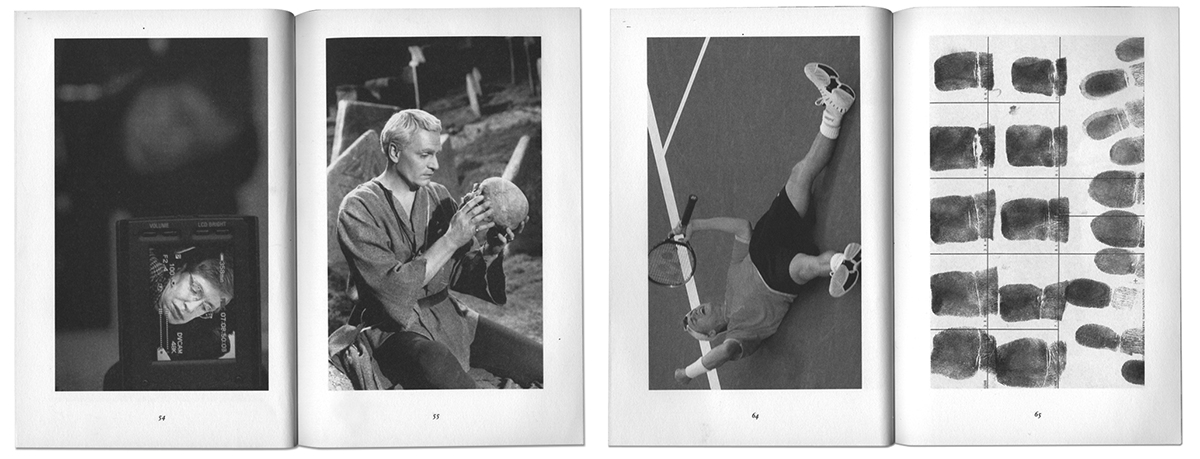
Then: “After forever, I got out of bed and went to the closet where I kept the phone.” (68) We have flipped through the scrapbook with Oskar, pausing where we feel like it, noticing whatever takes our fancy, perhaps remembering links from the story that help explain the inclusion of these images. For example, Oskar writes fan mail to Steven Hawking asking to be his protégé, is cast as Yorrik in a school production of Hamlet, remembers a photograph of a tennis player from the newspaper he and his father read the night before Thomas died, and was taken to be finger printed at the police station by his mother. Clumped together, without captions, this section allows the reader time to reflect. For example, the fourth image—the page of fingerprints—is particularly haunting. Oskar describes the experience of visiting the police station as “great”—in a way only a child could—but these little, squashed fingerprints are recorded so Oskar’s body can be identified in a repeat terrorist attack or other catastrophe. The idea of Oskar’s mother bundling him off to the police station to have this done is a poignant display of her anxiety in the aftermath of the tragedy. Oskar may not understand the significance, but most readers do. Likewise, the tennis player splayed in either victory or defeat is included simply because Oskar and his father looked at it in the paper the night before his death. The content of the image is less relevant than our understanding of its sentimental associations: Oskar kept this newspaper clipping because he shared it with his father. The ephemera is powerful not simply for the picture it depicts, but for the story behind its collection.
Another image from this sequence resonates with many readers:
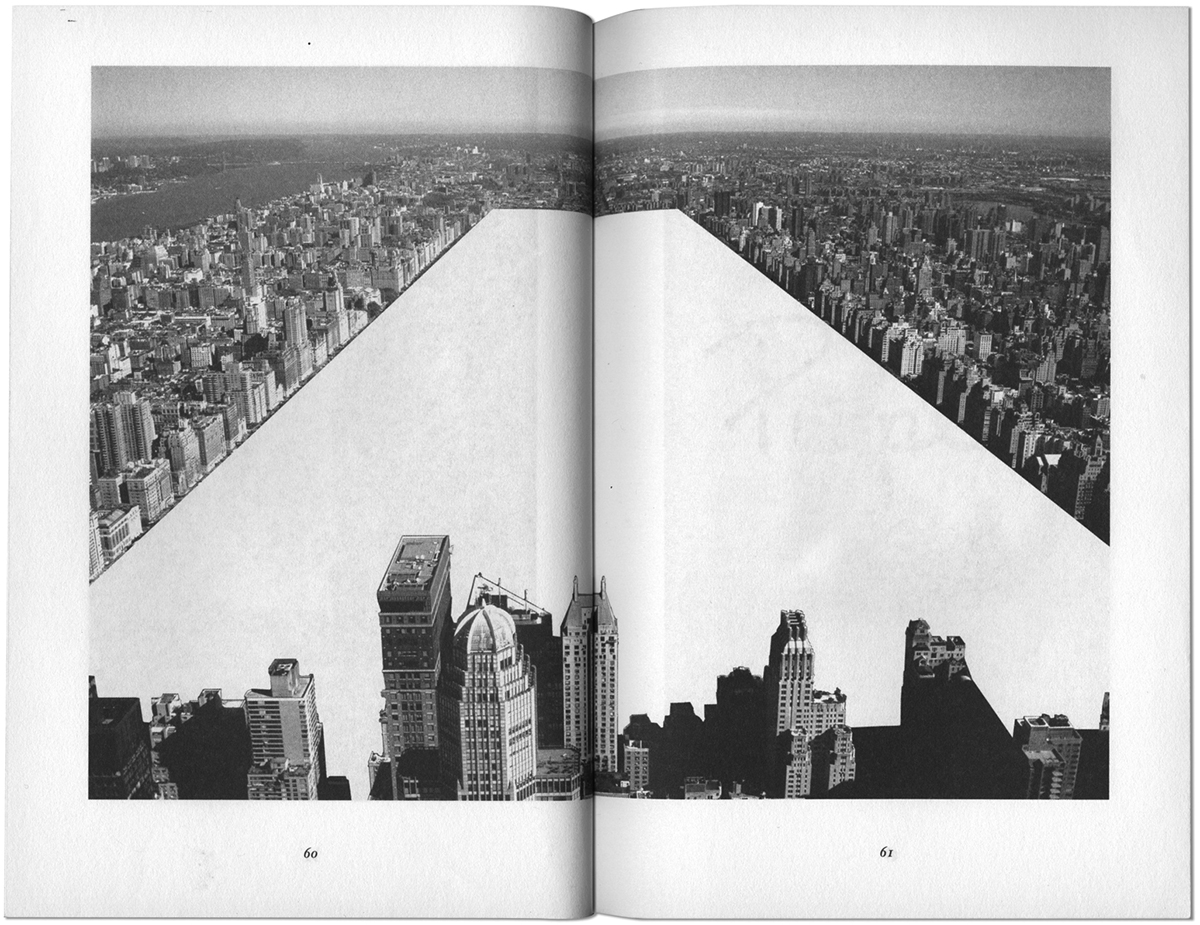
This is the only image that crosses over a double-page spread in this section from Oskar’s scrapbook. It has obviously been manipulated. We are not told Oskar cut Central Park out of this photograph, but knowing it is from his scrapbook, we make the conceptual leap. One reading relates to a game Oskar and Thomas played called “Reconnaissance Expedition”. Thomas set Oskar puzzles to solve: the game at the time of his death involved finding “something”, “somewhere” in Central Park. Thomas handed him a map of the park, with no other clues. The cut-out park could reference the space Oskar was to explore. Alternatively, it could suggest he will never know the “answer” to this game. But, something else is at work here. Cutting is an act of violence. Removing a huge, iconic section of the city is symbolically parallel to the space left after the Towers fell—Ground Zero. Although this image does not provide any new information or alter my understanding of the plot, something lingers, asking to be read, if the reader chooses to engage with it. My interpretation of this image considers how it relates to events in the story, but also to the way it was produced; the materiality of the image is also meaningful.
All of these photographs relate to anecdotes in the written text, but do not necessarily appear near that text. Rather than illustrating anecdotes, the uncaptioned photographs allow the reader to see through Oskar’s eyes, providing a rich visual description of the world he exists in, and is a product of. Making the scrapbook and the quest to find the lock are activities through which Oskar tries to make sense of the world after a catastrophic public and personal loss he is unable to process.
In a review of The Curious Incident of the Dog in the Night-Time, James Bucky Carter (2007) describes a trend in young adult fiction where characters are “making use of their innate visual literacy skills”, skills learnt by “video game-playing, cell phone picture-taking, music video-watching people” (n.p.). Although not a young adult novel, Oskar’s “innate visual literacy skills” are apparent in his scrapbook. Similar to Christopher, the narrator of Curious Incident, Oskar includes these devices as both a coping mechanism (a way to understand his world) and a communication tool (it is logical to him to show, rather than describe, these images).
The most effective way to evoke a bombardment of random images is to show them. Sharing Oskar’s experience heightens our empathy with him. The language of Oskar’s world is coloured by images from the Internet, newspapers, and other visual media. Foer relates an anecdote about surfing the Internet while writing the novel:
I was browsing the Internet one night – allowing links to carry me farther and farther from the news sites I normally visit – and was shocked by the breadth and graphicness of the images I quite unintentionally came across. There’s something exhilarating about being so close to everything at once. It made me think about the visual environment in which [children] are now developing. (Houghton Mifflin, 2005)
This anecdote, from the publisher’s press release, sheds some light on Foer’s use of found images within the novel. Foer shows us, through Oskar’s eyes, how incomprehensible some of this content may be to a child. Oskar spends time searching the Internet, allowing links to carry him farther and farther from places a child should be looking. He recognises some of the images he finds are violent and disturbing, but pastes them in the scrapbook anyway:
Ray Black was in prison, so we weren’t able to talk to him. I did some research on the Internet and found out that he was in prison because he murdered two kids after he raped them. There were also pictures of the dead kids, and even though I know it would only hurt me to look at them, I did. I printed them out and put them in Stuff That Happened to Me. (243)
Tellingly, Oskar calls his scrapbook Stuff That Happened To Me; by viewing these images, Oskar feels these things have “happened” to him. The photographs of these children are not included on the pages of the novel – the fate of these children is chilling but not ‘incredibly close’ to Oskar’s world. However another disturbing image—the falling man—is incredibly close to Oskar, and appears several times. Oskar comes back to this image over and over, speculating whether it is his father. Although he is haunted enough by the children to put them in his book, Oskar is not described returning to dwell on their photograph. Perhaps Foer is showing us that we cannot predict what will affect us – particularly children – in an ‘extremely loud’ way.
Reproductions of the photograph appear throughout the novel, haunting the reader as this vision haunts Oskar. In Grandma’s final chapter, she describes a dream in which the events she witness during the bombing of Dresden begin to reverse:
[A]ll of the collapsed ceilings re-formed above us. The fire went back into the bomb, which rose up and into the bellies of planes whose propellers turned backward, like the second hands of the clocks across Dresden, only faster. (306)
After Grandma’s dream, the novel closes with Oskar’s final chapter. He takes out Stuff That Happened To Me, tears out the grainy photographs of the falling man, and reverses the sequence:
Finally, I found the pictures of the falling body. Was it Dad? Maybe. Whoever it was, it was somebody. I ripped the pages out of the book. I reversed the order, so that the last one was first, and the first was last. When I flipped through them, it looked like the man was floating up through the sky. (325)
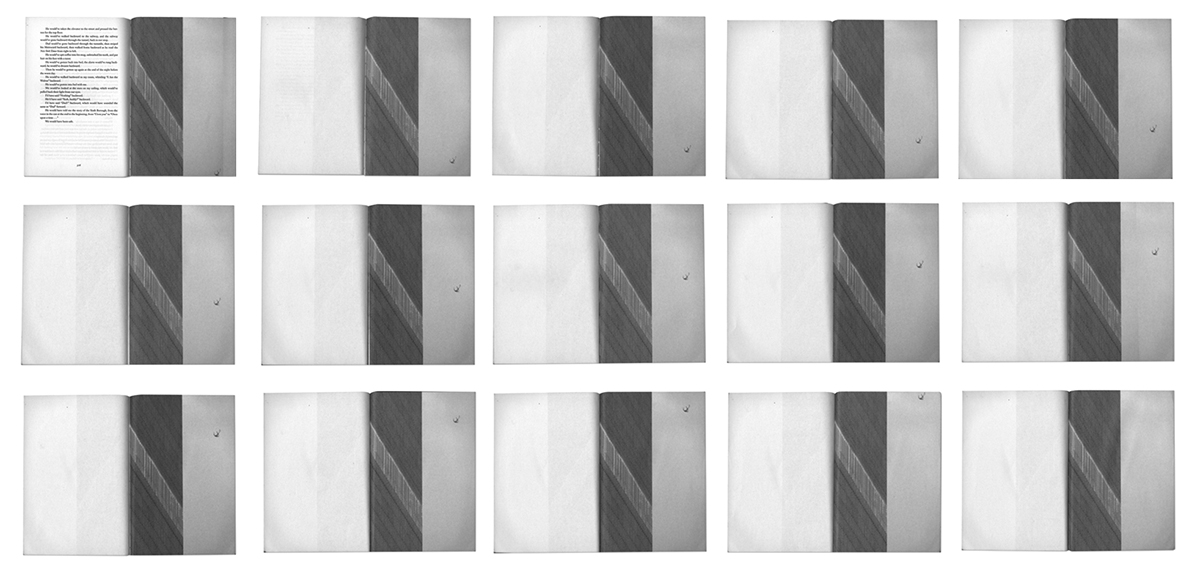
The body floats back up into the building, reversing time and undoing the tragedy. The final fifteen spreads show this. As readers, we are forced to participate in this act, making the image come “alive” in our hands. It is at once beautiful and terrifying, especially if the photographs are real, since we visually reverse a man’s actual death.
The series of photographs is obviously manipulated. Aside from the imprint page calling them “photoillustrations”, a body falling from a building would not free-fall frozen in exactly the same position, as it is in all these images. Does the fact that these images are manipulated make them ‘inauthentic’ and less powerful, even though the original photograph is ‘real’? Susan Sontag states, “For the photography of atrocity, people want the weight of witnessing without the taint of artistry, which is equated with insincerity or mere contrivance.” (1977: 23)
As they spend time together, Thomas Senior and Oskar develop their own special “Reconnaissance Expedition”, to dig up Thomas’ empty coffin. Thomas’ father and his son are united at last. One sleepless night, Oskar has a thought unlike the usual inventions he imagines: “It was closer to me, and louder. I didn’t know where it came from, or what it meant, or if I loved it or hated it. It opened up like a fist, or a flower. What about digging up Dad’s empty coffin?” (259) Immediately following this passage, these images of Thomas Senior’s hands are reproduced:
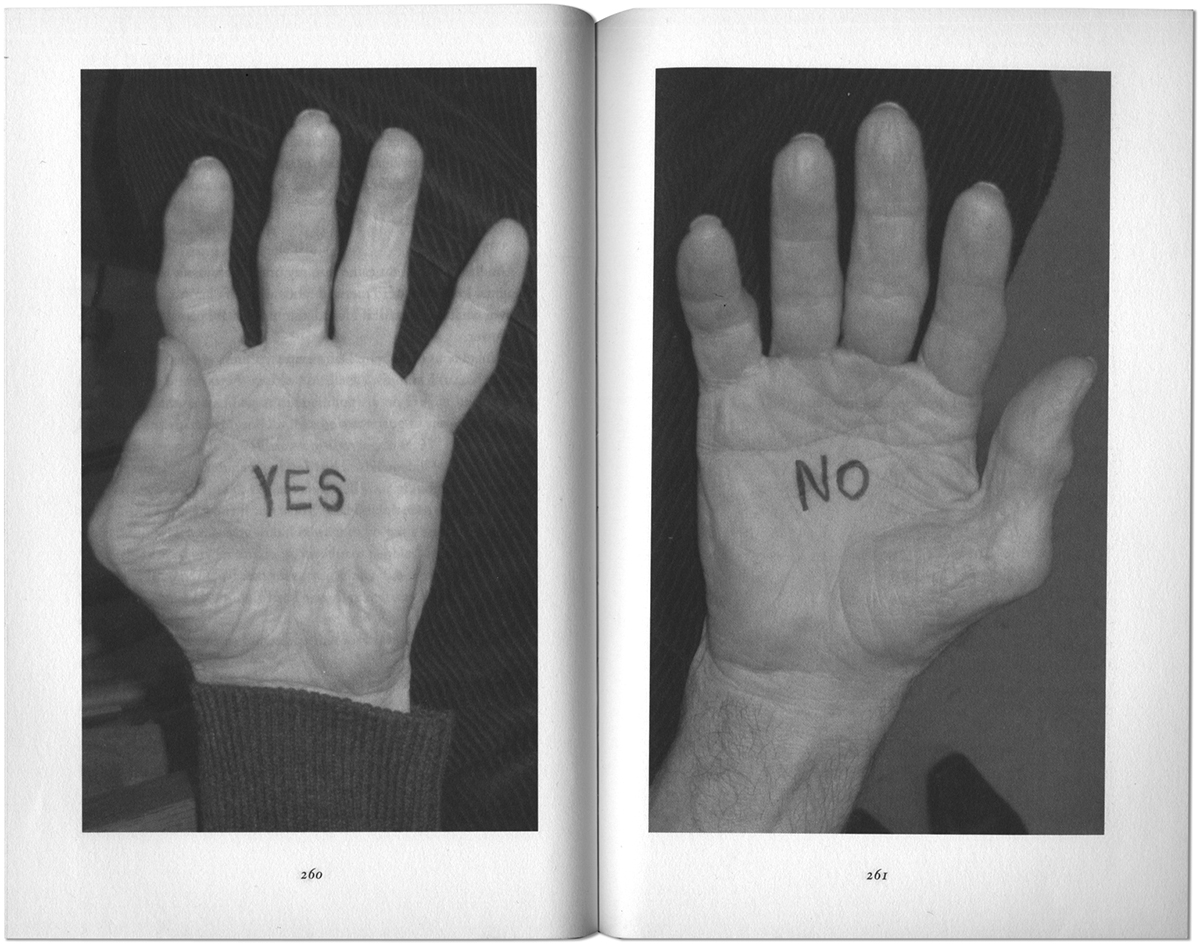
The placement of the image is confusing. It hovers after Oskar’s chapter, but just before Thomas Senior’s chapter making it difficult to determine who is supposed to have taken or included it. It is feasible that Oskar has taken the photograph of Thomas Senior’s hands. But, none of Oskar’s other chapters ends with a photograph, and it seems unlikely that he would so cleverly place this image directly after the idea to dig up the coffin. The only photographs that appear anywhere else in Thomas Senior’s chapters are of doorknobs. It seems then, that neither Oskar nor Thomas Senior is responsible for these pages, which is inconsistent with the other photographic devices in the primary text. Nevertheless, the placement of this photograph in the text is effective. Floating between Oskar’s idea of digging up the grave and Thomas Senior’s description of the event, we are invited to linger on the double page spread, uninterrupted by written text, as a kind of dramatic pause. Apparently, it is sometimes necessary to “break the rules” or conventions to achieve a specific literary affect.
A different kind of inconsistency also affected my reading of this device. Although presented on the gnarled hands of an old man—presumably Thomas Senior—these words look drawn in pen, not tattooed.[4] This may not register with, or trouble, some readers, but for some, the artifice of the fictional world is momentarily broken. Unlike the photographs that Oskar is supposed to have taken, where the blurriness implies an amateur photographer, the inauthentic look of this photograph is frustrating: the image should either be reproduced to convincingly look like a tattoo or not be included at all.
Conclusion
Not all readers respond to the images as enthusiastically as the judges at the V&A Illustration Awards. Disparagers have described them as “gimmickry”, an adjective that appears with surprising frequency in reviews of the novel. One review is subtitled “Gimmicks drown out power, poignancy” (Upchurch 2005) and another,“A bag of tired tricks” reads:
What may hurt the book even with its intended audience are the various diversions that both writer and publisher seem to have thought would constitute a selling point … After a while the gimmickry starts to remind one of a clown frantically yanking toys out of his sack: a fatal image. (Meyers 2005 n.p.)
Gimmick is a marketing term, referring to a novelty feature or unique selling point: free steak knives or a two-for-one “gift”. A gimmick is a supplementary incentive to purchase, often only loosely associated with the primary product or service. Transferred to a literary context, describing these photographs as gimmicks dismisses them as supplementary marketing strategies, rather than understanding them as literary devices that are integral to the text. In response to criticism of the graphic elements in his novel, Foer states:
It’s a shame that people consider the use of images in a novel to be experimental or brave. No one would say that the use of type in a painting is experimental or brave. Literature has been more protective of its borders than any other art form—too protective. Jay-Z samples from Annie—one of the least likely combinations imaginable—and it changes music. What if novelists were as willing to borrow? (qtd. in Hudson 2005 n.p.)
In another interview, the author further defends his use of graphic devices, stating: “Most of what I do in my books I do exactly because I can’t explain in any other way.” (qtd. in Gerber and Triggs 2006 n.p.). In designing his novel to communicate as effectively as possible, Foer chooses what to verbalise and what to visualise. In a novel that deals with the aftermath of a highly visual catastrophe, narrated by a protagonist born into a highly visual world, graphic devices communicate in ways that words alone could not.
Works Cited
Bigsby, Christopher. Writers in Conversation. Vol. 2. Norwich: Arthur Miller
Centre, 2001.
Carter, James Bucky. “Imagetext in ‘The Curious Incident of the Dog in the Night-time’”. ImageText: Interdisciplinary Comics Studies 3.3 (2007):
PAGES. < http://www.english.ufl.edu/imagetext/archives/v3_3/carter>.
Accessed 11 February 2008.
Frostrup, Mariella. Unusual Typography. 2007. Radio Broadcast, Open Book,
BBC radio 4, <http://www.bbc.co.uk/radio4/arts/openbook/openbook_20070211.shtml>.
Gerber, Anna and Triggs, Teal. “Acrobat Reader.” Print 60.4 (2006): 62.
Hammond, Margo and Ellen Heltzel. Comic Books for Big People. 2004. Poynter Online, <http://www.poynter.org/column.asp?id=57&aid=70817>. Accessed 14 March 2006,
Houghton Mifflin Publishing A Conversation with Jonathan Safran Foer.
Houghton Mifflin, 2005. <www.houghtonmifflinbooks.com/booksellers/press_release/extremelyloud/>. accessed 17 July 2009,
Hudson, Gabe. “Everything is Interrogated.” The Village Voice. (March 30-
April 5, 2005): 32-35.
Jain, Priya. “Extremely Loud and Incredibly Close.” 2005. Salon.com, 20
March. <http://dir.salon.com/story/books/review/2005/03/20/foer/index.html>. accessed 15 March 2006,
Khan, Mishaal. “Safran Foer Scoops Top V&A Illustration Award.” Design
Week 20.50 (2005): 9.
Meyers, B.R. “A Bag of Tired Tricks.” The Atlantic Monthly (May 2005).
<http://www.theatlantic.com/doc/200505/myers>. Accessed 27
February 2007.
Sadokierski, Zoe. Visual Writing: A Critique of Graphic Devices in
Hybrid Novels, From a Visual Communication Design Perspective.
Doctoral Dissertation. University of Technology, Sydney, 2010,
Safran Foer, Jonathan. Extremely Loud and Incredibly Close. London:
Hamish Hamilton / Boston: Houghton Mifflin, 2005.
Sontag, Susan. On Photography. New York: Penguin Books, 1977.
Sontag, Susan. Regarding the Pain of Others. London: Penguin Books, 2003.
Upchurch, Michael. “Extremely Loud and Incredibly Close: Gimmicks Drown Out Power, Poignancy.” The Seattle Times (14 April 2005): K.10.
Wulff, Wendie. “Designing Collaborative User Interfaces: Lessons from
Writer / Graphic Designer Interaction.” ACM SIGCHI Bulletin 21.3
(1990): 60-63
[1] In the novel, both Oskar’s father and grandfather are called Thomas—I refer to the grandfather as Thomas Senior here to avoid confusion.
[2] For a more detailed analysis of the doorknobs within the text, see Sadokierski 2010(110–117).
[3] Credited on the imprint page as: “photo illustration based on a photograph by Lyle Owerko.” According to his website—www.owerko.com—Lyle Owerko shot six rolls of film of ‘jumpers’ who leapt from the top of the World Trade Centre. He published a book of these ‘falling man’ photographs called And No Birds Sang.
[4] Safran Foer took this photograph himself, writing the works in marker pen on an old man who was willing to model for the book. (Hudson 2005)
